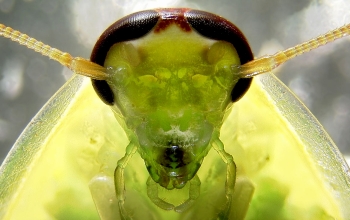Multimedia Gallery
The cockroach Panchlora nivea, from the Caribbean
Caribbean Cockroach
A cockroach from the Caribbean that is also found in southern Florida. It has various common names like Cuban cockroach and green banana roach. The scientific name is Panchlora nivea. Adults are less than an inch long and are excellent flyers.
This image was taken by David D. Yager, associate professor of integrative neuroscience in the Department of Psychology at the University of Maryland College Park. Research in Yager's lab particularly focuses on discovering how insect auditory systems are able to acquire and process acoustic information to yield complex, adaptive behaviors. Insects have evolved tympanate hearing many times, and Yager's lab uses the unique auditory system of the praying mantis as a model for auditory system evolution. These animals have a single 'cyclopean' ear in the middle of their body that is sensitive exclusively to ultrasound. Neurophysiological projects in the lab have focused on several auditory interneurons and their role in processing and/or relaying information to the brain. Through comparative studies of other insects, the Yager lab hopes to understand the transition from earless to eared. The precursor structures to the ear itself have been identified in mantids' closest relatives, the cockroaches (earless). (Date of Image: 2005)
Credit: David D. Yager, University of Maryland
See other images like this on your iPhone or iPad download NSF Science Zone on the Apple App Store.
Special Restrictions: This image may not be sold in any form and may not be used for commercial advertising or any for-profit use. Use in print media with circulation greater than 10,000 requires permission of copyright holder, David D. Yager. Contact Yager via e-mail at ddyager@umd.edu. To learn more about Yager's research, visit his laboratory.
Images and other media in the National Science Foundation Multimedia Gallery are available for use in print and electronic material by NSF employees, members of the media, university staff, teachers and the general public. All media in the gallery are intended for personal, educational and nonprofit/non-commercial use only.
Images credited to the National Science Foundation, a federal agency, are in the public domain. The images were created by employees of the United States Government as part of their official duties or prepared by contractors as "works for hire" for NSF. You may freely use NSF-credited images and, at your discretion, credit NSF with a "Courtesy: National Science Foundation" notation.
Additional information about general usage can be found in Conditions.
Also Available:
Download the high-resolution JPG version of the image. (602 KB)
Use your mouse to right-click (Mac users may need to Ctrl-click) the link above and choose the option that will save the file or target to your computer.

